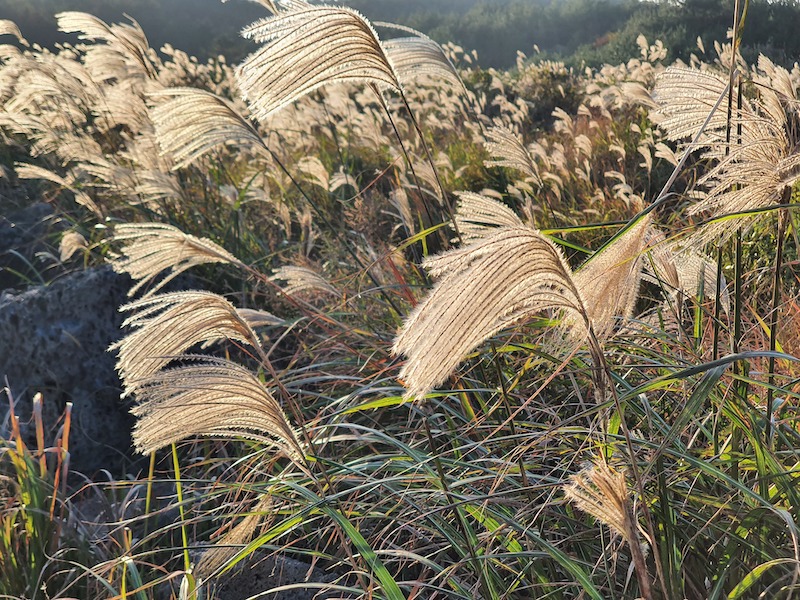Growing Maiden Grass
Maiden grass, also known as Miscanthus sinensis or silver grass, is a family of ornamental grasses with arching stems and feathery plumes. The fluffy, silvery plumes appear in late summer and dry to a tan color that remains all winter. It grows easily in most garden conditions and tolerates both clay and sandy soils.
Some of the cultivars are quite large and reach 12 feet high and 10 feet wide, while more compact varieties will stay 3 – 4 feet in size. These grasses make elegant, low-maintenance screens for the back of a border. Make sure you research the size of the cultivar and provide enough space for it to reach its mature size.

Planting Maiden Grass
Maiden grass performs best in full sun, with at least 6 hours of sun a day. It prefers evenly moist, well-drained soil of average fertility. It tolerates clay, sandy, and poor soil, as long as the soil drains well. To plant this grass, find a sunny location with enough space for it to reach its mature size. Dig a hole just wide enough for the rootball, and set the the crown slightly above the soil surface to allow the soil to settle over time.
Backfill the hole with native soil and avoid mixing in soil additives, such as manure or compost. Saturate the planting hole with water to fill in any air gaps around the roots. Spread a layer of organic compost around the root zone to conserve moisture.

Watering Maiden Grass
Keep newly planted maiden grass moist during the first year after planting. Over a few years, it will develop drought tolerance and will need only occasional supplemental water over the summer. Water it more regularly during hot, dry weather to encourage healthy growth. Containers dry out faster than plants in the ground and should be watered whenever the top two inches of soil feel dry.
Fertilizing Maiden Grass
This ornamental grass does not need to be fertilized. You can apply a layer of organic compost around the base of the grass each spring to improve your soil composition. Application of fertilizers rich in nitrogen can weaken this grass and cause it to flop.
Pruning Maiden Grass
Maiden grass will go dormant in the winter, but the dried leaves and flower stalks can be left in place to provide winter interest in the landscape. In early spring, this grass should be cut back to make room for new growth. Tie back the dried foliage, and use a pair of sharp, sterilized pruning shears or a power hedge trimmer to lob off the grass to about 6 inches above the ground. Be sure to wear long sleeves, gloves, and eye protection while pruning this robust grass.

Caring For Maiden Grass in Pots
Maiden grasses, especially the compact varieties, are easy to grow in containers. Choose a frost-proof container with large drainage holes if your plant will be outside all winter. The container should be big enough to accommodate the large root system of maiden grass.
Use potting soil that is for specifically designed for containers to prevent water-logged soil. Cover the roots with soil only to the depth the grass was originally planted, and leave a couple inches at the top of the container for watering. Water regularly during the summer when the top two inches of soil feel dry.
Winter Care for Maiden Grass
Maiden grasses are typically hardy in zones 5 – 9 and will not need any special winter care. At the lower end of its hardiness range, you can protect the crown from severe cold weather by heaping mulch around the base of the plant. In late fall, the foliage will die back and turn brown.
You can leave the clumps standing for winter interest, and cut this grass back to about 6 inches above the ground in the spring. This perennial grass will come back each spring and is expected to live for 15 – 20 years.

Common Care Questions About Maiden Grass
Is Maiden Grass An Annual Or Perennial?
Maiden Grass is a perennial ornamental grass. This perennial makes dense clumps of arching, grassy foliage in a variety of widths and colors.
Should Maiden Grass Be Cut Back?
Cut it back in the late winter/early spring before new growth appears. Cut 3 inches from the ground using hedge clippers.
What Is The Growth Rate Of Maiden Grass?
It's a slow grower, only growing about a foot in its first year, but by its third year, it may be up to 8 feet tall. It can be planted in the spring or fall, although spring is preferred to give the plant just enough time to establish roots before winter.
What Happens If You Don't Cut Maiden Grass Back?
Generally, ornamental grass may look messy when not cleaned up but they also might spread their seeds around the area. New growth in the spring may be difficult to grow through the old foliage.
Why Is My Maiden Grass Turning Brown?
There were several reasons why your Ornamental Grass is turning brown. You want to make sure that you're not overwatering, underwatering, and not letting the disease spread further. Otherwise, the grass will die.
Is Maiden Grass Deer Resistant?
Ornamental Grasses are deer-resistant plants. It is usually ignored by Deer.
Is Maiden Grass Poisonous?
Maiden Grass is non-toxic to humans but can be harmful to some pets i.e. dogs, and cats when consumed.
Is Maiden Grass Edible?
Though this plant is non-toxic, it is not recommended to be consumed by humans or any animals.
How Far Apart Do You Plant Maiden Grass?
Preferably 3 to 6 feet apart so that it can have adequate space for clumps when they spread.
Is Maiden Grass Invasive?
Yes, Maiden Grass is extremely invasive in some places. However, you can have alternatives such as Switch Grass and Giant Sacaton, which are native ornamental grass and less invasive than others.
When Do You Plant Maiden Grass?
You can plant Maiden Grass any time of the year but would ideally prefer to be planted in Spring because it's when an ornamental grass can establish a good root system.
Have a question about Maiden Grass Plant? Fill out the form below and we will try and get back to your question as soon as possible. We may even feature your question in this article to help other gardeners!
 |
Author Jessica Mercer - Published 7-13-2022 |
